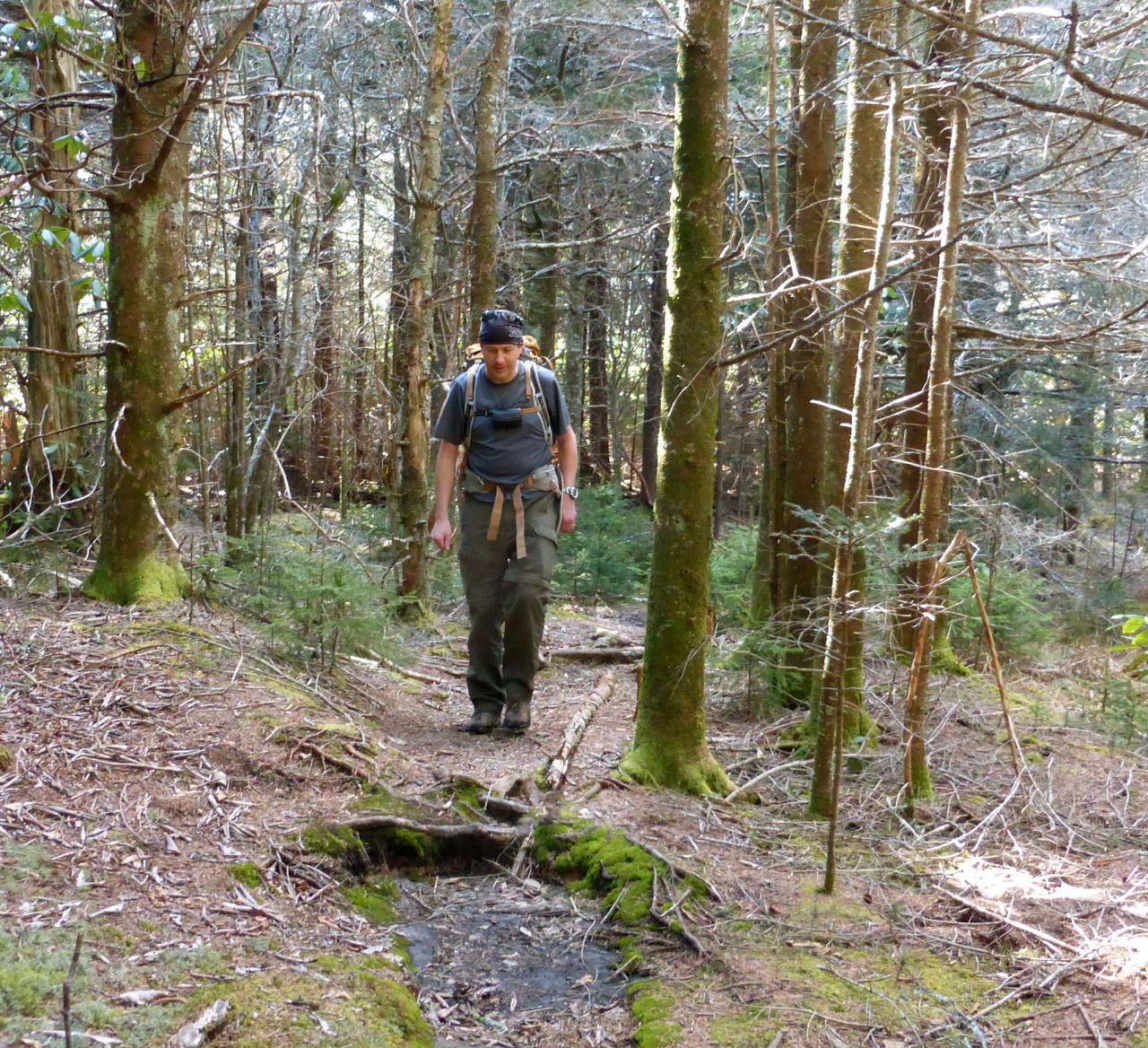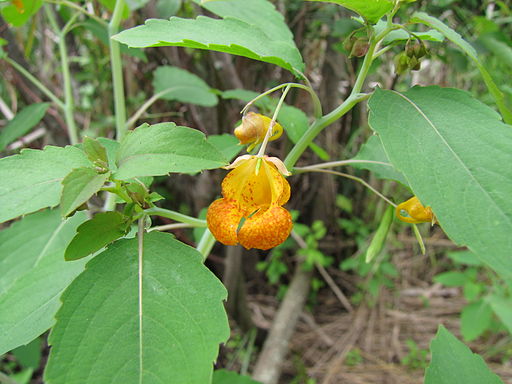
Your hiking companion didn’t know better when he joined you for a backpacking trip in the Appalachians. The trails traverse through dense mountainous woodlands and open pastoral landscapes. The hiking here is rugged, with the constant ascents and descents, climbing over and under fallen trees, meandering around leafy plants and thorny bushes. Then there is the hopping across streams on slimy, algae-covered rocks and trying to avoid tripping over the exposed tree roots.
The hiking looks easy, but it never is.
At the intersection of the trail, an old splintered wooden trail post is mounted into the dirt. It marks the trail name and distance. Your friend is tired and sits down to rest his back against the post. He marvels at the lush ivy plant growing along that spot, brushing his fingers across the soft green foliage. He then pulls his hand away to clear off the sweat running down his face.
As you approach, you mention all the poison ivy where he is sitting.
Uh oh.
It’s a hot day, and it’s about to get itchy too!

In just a short time, your friend’s hand and face will likely be covered in a nasty rash caused by the poison ivy.
You have no anti-itch remedies in your first aid kit, no baking soda, steroid ointments, calamine lotion, or hydrocortisone. You’d be cruel to let him suffer for the rest of the trip.
What can you do for him?
How to Treat Poison Ivy and Poison Oak when Backpacking
The urushiol oil, a clear liquid compound found in the sap of poison ivy, produces an itchy rash in most people who touch it. According to the American Academy of Dermatology, about 85% of people are allergic to the resin [1]. Because urushiol oil is soluble in soap, the best defense is to wash your skin with soap and water immediately after contact with the plant. Sometimes that is not possible on the trail. You might not have enough water available when it happens. Fortunately, as you’ll find out here, there are other options you can use to prevent a rash. These apply to all the common poisonous plants, including poison ivy, poison oak, poisonwood, and poison sumac.
- First, wash the exposed skin with cold water within 10 minutes of exposure. You must dilute the urushiol oil as soon as possible to prevent a rash. If you have soap with you, use it. Not all backpackers carry biodegradable soap. In that case, just rinse with cold water. Although urushiol is not soluble in water, rinsing the skin with plain water is better than doing nothing at all. If you can’t find a nearby spring, flush with the treated drinking water you have. Even if it is too late to prevent the rash, excess oil should be washed off. Otherwise, it will remain on the skin where it can spread. Do not wash off the oil with your washcloth/bandana; otherwise, you might spread the oil to other parts of your body.
- Do not rinse your skin with warm or hot water! It is not like you have a hot tap at your disposal in the wilderness, so it seems a little odd to say this; however, one can never assume. You might be hiking in an area with hot springs or just finished treating your water by boiling it. If so, don’t use that water. Hot water opens the pores and enhances the penetration of the oil into the skin.
- Wash anything else that came into contact with the plant, such as your clothing, dog, shoes, and laces. If you can’t wash clothing or gear with soap while on the trail, do so when you get into town. Washing with soap is essential because the urushiol oil remains active outside the plant and is not soluble in water alone. Otherwise, the oil will continue to produce a rash for up to 5 years.
- If you don’t have water but carry an alcohol-based hand sanitizer or alcohol wipes, clean the area with that. Smear it directly on the skin. Note: some sources say that the alcohol will help dissolve the oil from the skin, while other sources say it accelerates the poison’s penetration into the skin. The latter doesn’t make sense to me. Alcohol is a solvent and dries out the skin, thus retracts the pores. So, in theory, alcohol should work.
- Consider carrying Tecnu in your first aid kit. If you think you made contact with a plant, apply it to the skin immediately. The scrub uses a botanical-based solvent, Grindelia Robusta, which dissolves the urushiol oil.
Getting Relief from a Poison Ivy/Oak Rash
Sometimes you don’t realize you’ve touched a poisonous plant until you develop a nasty rash. In that case, you will need to find relief from the itching. There is no reason that a poison ivy rash should ruin your backpacking trip or force you to backtrack into the nearest town for first-aid. Here are a few things you can use in the wilderness to alleviate the discomfort.
- Many long-distance backpackers carry Emergen-C tablets for nutritional support. If you are one of them, you are in luck. Emergen-C is full of Vitamin C (ascorbic acid), and when applied topically to the skin, it provides relief. You can apply Vitamin C in several ways. One is to crush the vitamin C powder / Emergen-C tablet and add a small amount of water to make a paste and apply to the skin. Another way is to wet the exposed area of the skin and rub the tablet over it. A third option is to take it as it was designed (orally). Vitamin C helps with the histamine response. Any conventional antihistamine tablet (such as Benadryl) will also help with the inflammation and itching. Take 2x daily or as directed.
- If you get blisters, a simple method to temporarily stop the itching is to pour hot water over the blisters. Boil a pot of water, let it cool slightly, and pour it directly over the blisters.
- Relieve itching with these two common botanicals: Gumweed and Jewelweed. The sap of these common flowering plants relieves the itching and inflammation caused by exposure to any urushiol-containing plants. They also have a soothing effect on stinging nettles and insect bites, too! Finding these plants will depend on where you are hiking.
If hiking in the Western U.S., look for Grindelia (Grindelia robusta) or Gumweed.
The common name “gumweed” is because the yellow daisy-like petals contain a sticky resin. Squeeze the petals to extract the resin and apply directly to the skin. Grindelia is most commonly found growing in dry soils in California and Nevada

If hiking in the Eastern U.S, look for Jewelweed (Impatiens capensis), also known as Forget-me-nots, Impatiens, and Snapweed.
This common flowering plant is easily recognized by the trumpet-shaped flowers that hang from the plant.
Cut open the stem and squeeze it to release the juice, and rub it into the skin. Jewelweed grows in a similar climate with poison ivy; however, that does not mean you’ll find it nearby. Jewelweed flourishes along creek beds in damp and shady areas, whereas poison ivy grows in sun or shade. Jewelweed is also most common along the east coast, from northern Florida to southern Canada, and blooms from May through October.

Article sources
Vitamin C and histamine response: http://www.ncbi.nlm.nih.gov/pubmed/1578094
Disputes the efficacy of jewelweed to prevent poison ivy rash; the mash is what works; the extract doesn’t: http://www.ncbi.nlm.nih.gov/pubmed/22766473
Jewelweed remedy: http://www.altnature.com/jewelweed.htm
6 thoughts on “Relief from Poisonous Plants while on the Trail”
When I was hiking along the Cornwall Coast in England we used plantain weed leaves (crushed) on the stinging nettle scratches. They also work well on bites. The east coast states have lots of it.
Thank you for the tip, Carol! Identification of Common Plantain and Medicinal uses for Plantain
I was in Yucatan Mexico and backed into a Poisonwood tree aka chechem. One of the Mayans gave me some leaves from the Chaka tree and said it was the cure. I finely diced the chaka leaves and added it to some lotion. I cleaned the leg that I knew was touched, then applied the chaka cream and covered it with plastic with electrical tape to protect clothing, furniture, and bedding. The next day the hot spots on that leg were gone, but I could feel some hot spots on the other leg. I was told that chaka only worked if applied immediately, but figured I should try it. It cleared up!. Not a single blister!
I use hot water as hot as I can stand without it burning my skin.Running it over the itchy area for several minutes until I feel relief from the itch .It relieves the itch for up to 8 hours .Rinse and repeat…👍
Thanks for the information. While I have the right stuff to clean my skin, my clothes will carry the oil for the remaining days I am backpacking. What do you suggest to avoid constant contact with the oil knowing these are the only clothes I have to wear? Is there any way to pretreat my clothes?
I am unaware of any pre-treatments to prevent the urushiol oil from bonding to clothing fibers. The DWR ‘spray-on’ and ‘wash-in’ treatments coat fabric to repel water rather than oil and are meant for waterproof materials. If you’ve had exposure on the trail and have Tecnu Original, it can be applied directly to clothing and skin without water to break the urushiol’s oil bond to skin/gear. Use a bandana and rub Tecnu aggressively on the exposed clothing, and don’t use that cloth again until it gets laundered. When you get home, use a de-greasing detergent and hot water to wash the exposed clothing. At a minimum, I’d recommend having extra clothing you only wear for sleeping.